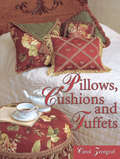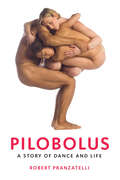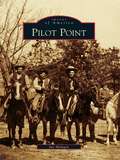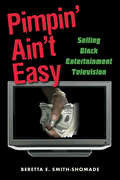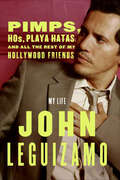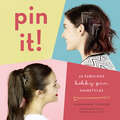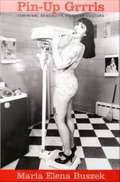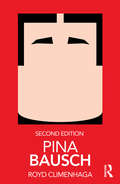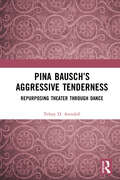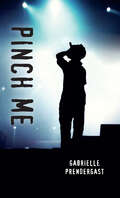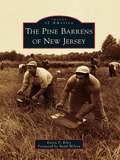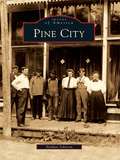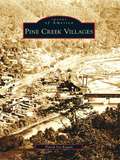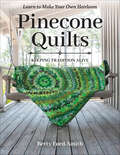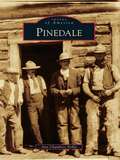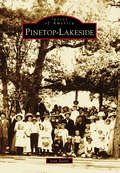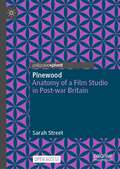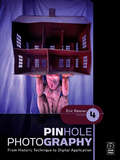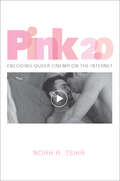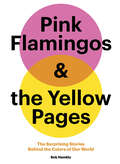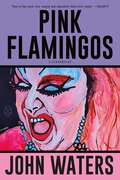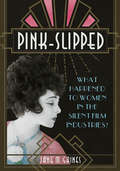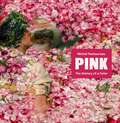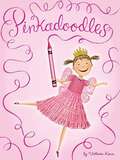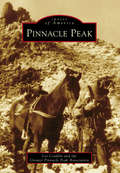- Table View
- List View
Pillows, Cushions and Tuffets
by Carol ZentgrafOver 50 pillow, tuffet, and cushion projects Clear, easy, step-by-step directions and abundant photographs Great tips on fabric selection, assembly, and sewing techniques Much of the fun of decorating is mixing and matching fabrics to create an inviting ensemble, and you'll find plenty of ideas in Pillows, Cushions, Tuffets. Author Carol Zentgraf shows you how to choose the fabrics and embellishments to create dozens of pillows, cushions, and tuffets - from funky to upscale designs. Inside, you'll learn all the sewing techniques and trade secrets to create gorgeous accessories for every room in your home.
Pilobolus: A Story of Dance and Life
by Robert PranzatelliThe dynamic history of the innovative, beloved, and critically acclaimed dance theater company, with revelatory behind-the-scenes details of its creators and significant works The ingeniously innovative and enduringly popular American dance theatre company Pilobolus has helped redefine, remix, and rejuvenate the essence of dance with its eclectic sensibility and daring athleticism. Now, for the first time, the story of Pilobolus, from its counterculture origins through its pop-culture triumphs and contemporary global acclaim, is revealed in a book that will entrance longtime admirers and newcomers alike. Written with unprecedented access to the company—with insights from unpublished archival materials and interviews with its founders, dancers, and current artistic directors—and featuring both classic and never-before-seen photos, Pilobolus offers previously untold details about the group’s history and the creation of its most significant works. Robert Pranzatelli describes the company's genesis in a Dartmouth dance class in 1971 and how Pilobolus revolutionized dance with its blend of sensuality, physical achievement, and visual wit. In these pages, the troupe performs on Broadway, travels the world, and by the late 1980s secures a place in dance history, while its growth is marked by periods of internal conflict, challenges, and change. As Pilobolus continues to morph, invent, and thrive with the arrival of new artists and collaborators, its story encompasses love, loss, grief, and rebirth, as well as insights into the secrets of the creative process—how performers and choreographers think and work. More than a history, Pilobolus is a narrative of life and art, and the vitality that infuses and inspires both when they align and inhabit each other.
Pilot Point (Images of America)
by Jay MeluginThe oldest town in Denton County, Pilot Point is situated atop the highest point in North Texas at a place that was once a landmark for wagon train pilots traveling through the region. In 1854, the town was platted and lots were sold, many to cross-country pioneers who were drawn to the abundance of fresh water, game, and fertile soil. The city began to grow more quickly after incorporation in 1867, and when the railroad arrived in 1880, Pilot Point became one of the busiest trading centers in North Texas, boasting both the largest cotton gin and university. From the early days of cowboys and cotton in the 1800s, to oil and cattle in the 1930s, to the changes that came with the 1960s, this new volume tells the unique story of Pilot Point.
Pimpin' Ain't Easy: Selling Black Entertainment Television
by Beretta E. Smith-ShomadeLaunched in 1980, cable network Black Entertainment Television (BET) has helped make blackness visible and profitable at levels never seen prior in the TV industry. In 2000, BET was sold by founder Robert L. Johnson, a former cable lobbyist, to media giant Viacom for 2.33 billion dollars. This book explores the legacy of BET: what the network has provided to the larger US television economy, and, more specifically, to its target African-American demographic. The book examines whether the company has fulfilled its stated goals and implied obligation to African-American communities. Has it changed the way African-Americans see themselves and the way others see them? Does the financial success of the network - secured in large part via the proliferation of images deemed offensive and problematic by many black communities - come at the expense of its African-American audience? This book fills a major gap in black television scholarship and should find a sizeable audience in both media studies and African-American studies.
Pimps, Hos, Playa Hatas, and All the Rest of My Hollywood Friends: My Life
by John LeguizamoFans of John Leguizamo's smash-hit one-man shows (Mambo Mouth, Spic-o-rama, Freak, and Sexaholix) have already gotten a glimpse into his life, but this book tells the whole story, carrying readers along on a wild journey from his childhood in Queens to his current home at the top of the Hollywood pyramid. An acclaimed director, producer, and play-wright, and one of the highest-paid Latin actors in the world, Leguizamo shares the stories behind his many roles—what inspired them and what transpired as he created them—while dishing on his personal relationships with his family, friends, and celebrity colleagues. Here is both an intimate self-portrait and a unique behind-the-scenes look at the magic and chaos of stardom, a keenly intelligent and insanely funny book that celebrates a remarkably talented artist's greatest achievement: growing up Latino in America and succeeding on his own terms.
Pin It!: 20 Fabulous Bobby Pin Hairstyles
by Annamarie TendlerBrightly colored pins styled into fun patterns and designs are the hottest new trend in hairstyling, and Pin It! gives short- and long-haired fashionistas the know-how to create 20 colorful bobby pin hairstyles for everything from an afternoon trip to the mall to an elegant party. Step-by-step photos make it easy for anyone to follow along, and the unique looks appeal to trendy teens and stylish young women as well as parents looking for a wholesome hair-styling book with fresh-faced appeal. With style tips to pull it all together and five DIY projects for personalizing bright and sparkly pins, this is the new must-have beauty book.
Pin-Up Grrrls: Feminism, Sexuality, Popular Culture
by Maria Elena BuszekSubverting stereotypical images of women, a new generation of feminist artists is remaking the pin-up, much as Annie Sprinkle, Cindy Sherman, and others did in the 1970s and 1980s. As shocking as contemporary feminist pin-ups are intended to be, perhaps more surprising is that the pin-up has been appropriated by women for their own empowerment since its inception more than a century ago. Pin-Up Grrrls tells the history of the pin-up from its birth, revealing how its development is intimately connected to the history of feminism. Maria Elena Buszek documents the genre's 150-year history with more than 100 illustrations, many never before published. Beginning with the pin-up's origins in mid-nineteenth-century carte-de-visite photographs of burlesque performers, Buszek explores how female sex symbols, including Adah Isaacs Menken and Lydia Thompson, fought to exert control over their own images. Buszek analyzes the evolution of the pin-up through the advent of the New Woman, the suffrage movement, fanzine photographs of early film stars, the Varga Girl illustrations that appeared in Esquire during World War II, the early years of Playboy magazine, and the recent revival of the genre in appropriations by third-wave feminist artists. A fascinating combination of art history and cultural history, Pin-Up Grrrls is the story of how women have publicly defined and represented their sexuality since the 1860s.
Pina Bausch: The Making Of Tanztheater (Routledge Performance Practitioners)
by Royd ClimenhagaThis newly-updated second edition explores Pina Bausch’s work and methods by combining interviews, first-hand accounts, and practical exercises from her developmental process for students of both dance and theatre. This comprehensive overview of her work offers new and exciting insight into the theatrical approach of a singular performance practitioner. This is an essential introduction to the life and work of one of the most significant choreographers/directors of the twentieth and twenty-first centuries. As a first step towards critical understanding, and as an initial exploration before going on to further, primary research, Routledge Performance Practitioners offer unbeatable value for today’s student.
Pina Bausch’s Aggressive Tenderness: Repurposing Theater through Dance
by Telory D. ArendellPina Bausch’s Aggressive Tenderness: Repurposing Theater through Dance maps Bausch’s pieces alongside methodologies of key theater and film practitioners. This book includes discussion of a variety of Bausch pieces, including Sacre du Printemps (Rite of Spring 1975), Kontakthof (Meeting Place 1978), Café Müller (Café Mueller 1978), Nelken (Carnations 1982), Arien (Arias 1985), and Vollmond (Full Moon 2006). Beginning with her approach as one avenue of dance dramaturgy, the author connects the content expressed in these pieces with theoretical conversations, works from other artists inspired by Bausch, and her own experiences, providing an examination that is both academic and personally insightful. Arendell reads all of these theatrical and film approaches into Bausch’s work to highlight how the time frame involves a cross-pollination between Bausch and the other artists that looks both backward and forward in its influences. Ideal for students of dance and theater, Pina Bausch’s Aggressive Tenderness shows how Bausch’s Tanztheater speaks a kinaesthetic language, one that Arendell translates into a somaesthetic exploration to pair a repurposed body ethic with movements that present new forms of embodiment.
Pinch Me (Orca Soundings)
by Gabrielle PrendergastAfter another night of girls, music and booze, seventeen-year-old pop star Darius Zaire falls out of bed and lands on the cruddy floor of his old bedroom. No mansion, no luxury cars, no platinum records. Now he's just ordinary Darren Zegers. Some kind of nightmare has erased everything that happened to change Darren the dweeb into Darius the multimillionaire. Now Darius has to face an ordinary day in the twelfth grade, suffering through remedial English and wondering what happened to the last three years, let alone all his fans and money. He desperately wants to return to his old life, but he is starting to worry that maybe this is reality, and it was his other life that was the dream. This short novel is a high-interest, low-reading level book for teen readers who are building reading skills, want a quick read or say they don’t like to read!
Pine Barrens of New Jersey, The
by Budd Wilson Karen F. RileyThe Pine Barrens of New Jersey cover 22 percent of the most densely populated state in the country. It is the largest stretch of open space between Boston, Massachusetts, and Richmond, Virginia. It reaches across 56 municipalities and 7 counties. The name came from early settlers who thought the area was a vast wasteland, but it is anything but barren. Underneath this incredible natural resource lies almost 17 trillion gallons of some of the purest water on earth. Stands of pitch pine gave birth to the charcoal industry, and its acidic swamps were used first for bog iron and later for cranberry production. Many firsts came from this area, including cranberry sauce, cultivated blueberries, and grape juice. Numerous industries have risen and fallen over time. Remnants of forgotten ghost towns bear witness to that history, but the real stories come from the people who lived and worked there.
Pine City
by Nathan JohnsonLaden with pines and interspersed with lakes and rivers, Pine City has long served as the gateway to Minnesota's Northwoods. Over the years, people have traveled through the area via the river, military road, railroads, and scenic highway. In the 1880s, as people of European decent were settling in, the crux of the community moved from Chengwatana, Ojibwe for "City of Pines," to a location west of there, nearer the rail line, called Pine City. The story begins with the fur trade and takes one through a fascinating journey of the logging industry, showing the rural community's transition from predominantly agricultural underpinnings to a more diversified economy. This collection of vintage photographs highlights Pine City's laboring people and other influences that have had roles in shaping what it is today-a city of great history, unique people, nostalgic small-town traditions, and mystifying legends.
Pine Creek Villages (Images of America)
by David Ira KaganPioneer settlers began arriving in Pine Creek Valley after the Revolutionary War, drawn to the pristine wilderness filled with towering white pines and hemlocks. In the 1880s, descendants of those settlers began extensive lumbering operations aided greatly by the arrival of the railroad through the valley. Additional logging railroads were rapidly constructed up the tributary runs to the great stands of trees. Pine Creek's villages flourished, with both large and small sawmills buzzing. Around 1910, when the great lumbering days ended, many of the village populations plummeted. Throughout the 20th century and into today, the area remains a popular tourist destination for fishing, hunting, and outdoor enthusiasts.
Pinecone Quilts: Keeping Tradition Alive, Learn to Make Your Own Heirloom
by Betty Ford-SmithDiscover the rich history of Pinecone quilts, try your hand at five stunning projects with helpful tips, and learn how to create your own quilt. Pinecone quilts, also known as Pine Burr, are made with folded triangles sewn side-by-side onto a foundation in concentric circles. Educator and quilter Betty Ford-Smith keeps the tradition of pinecone quilts alive by passing on the rich history of the Pinecone quilt and detailed instructions on creating your pinecone quilt. She shares her knowledge of Pine Cone quilting mastery and even some of her beloved teacher, Miss Sue, life&’s anecdotes and cautionary tales given to her during their quilting lessons together. · Make five home decor projects with helpful tips to assist along the way · Learn the origins and inspirations of Pinecone quilts and their place in Southern and African American history Browse through a gallery of student and author-made quilts and resources for learning more about African influences on Southern art
Pinedale
by Ann Chambers NobleJohn F. Patterson founded Pinedale in 1904 after proposing the establishment of a town along Pine Creek in western Wyoming. Patterson offered to build and stock a general store if local ranchers Charles Petersen and Robert Graham would donate five acres each for the site. Petersen and Graham agreed to this plan, a surveyor was hired, and Pinedale--named after the post office on Petersen's ranch--was officially established. Free town lots were offered to early settlers, and Pinedale was incorporated in 1912, becoming the farthest incorporated town from a railroad, and later from a major highway, in the country. The community survived in fierce isolation, and the townspeople originally made their living supplying the ranchers, outfitters, and tie hacks. Ranching and tourism helped sustain Pinedale from the beginning, and in the 1990s, the community underwent a fundamental change with the introduction of natural-gas mining in the area. Pinedale residents continue to live and thrive on this harsh but beautiful land.
Pinetop-Lakeside
by Joan BaezaIn 1984, the White Mountain communities of Pinetop and Lakeside in east-central Arizona undertook a "marriage of convenience" and incorporated. Historically, they could not be more different. Like rival sisters, one was pious and churchgoing while the other was wayward and fun loving. But in the best of American traditions, they formed a town government to provide services for their combined residents. Pinetop-Lakeside's history is as rough-and-tumble as that of any Western town. Settlement began with the establishment of Fort Apache in 1871. The cavalry post provided employment for freighters and skilled laborers, as well as a market for beef, hay, and grain. The 1880s brought colonists from the Church of Jesus Christ of Latter-day Saints. They built the dams and lakes that in the next century would become the basis for an economy based on outdoor recreational tourism. Today, Pinetop-Lakeside is a thriving community of approximately 4,500 residents. One thing that hasn't changed since the time of the pioneers is the natural beauty that defines life on the mountain.
Pinewood: Anatomy of a Film Studio in Post-war Britain
by Sarah StreetThis open access book examines how Pinewood came to be Britain’s dominant film studio complex, focusing on key years following the Second World War. It presents a revisionist, micro history of the studio and its longevity during a particularly turbulentperiod, explaining Pinewood’s survival at a time when other major film studios such as Denham closed. This book also provides contemporary insights into how Pinewood’s technologies, practices, and filmmaking methods compared to Hollywood’s. Thirteen films produced in1946–47 are analysed in detail, tracking how economic pressures engendered many creative techniques and innovative technologies. Prevailing cultures of management and labour organization are foregrounded, as well as insights into being a studio employee. These are vividly brought to life through an in-depthfocus on the in-house studio magazine Pinewood Merry-Go-Round, which provides rare details of sports and leisure activities organized at the studios.
Pinhole Photography: From Historic Technique to Digital Application (Alternative Process Photography)
by Eric RennerA respected guide for creatives, artists and photographers alike, Pinhole Photography is packed with all the information you need to understand and get underway with this wonderfully quirky, creative technique. Covering pinhole photography from its historical roots, pinhole expert Eric Renner, founder of pinholeresource.com, fully explores the theory and practical application of pinhole in this beautiful resource.Packed with inspiring images, instructional tips and information on a variety of pinhole cameras for beginner and advanced photographers, this classic text now offers a new chapter on digital imaging and more in depth how-to coverage for beginners, as well as revised exposure guides and optimal pinhole charts. With an expanded gallery of full-color photographs displaying the creative results of pinhole cameras, along with listings of workshops, pinhole photographer's websites, pinhole books and suppliers of pinhole equipment, this is the one guide you need to learn the craft and navigate the industry.
Pink 2.0: Encoding Queer Cinema on the Internet
by Noah A. TsikaIn an era where digital media converges with new technologies that allow for cropping, remixing, extracting, and pirating, a second life for traditional media appears via the internet and emerging platforms. Pink 2.0 examines the mechanisms through which the internet and associated technologies both produce and limit the intelligibility of contemporary queer cinema. Challenging conventional conceptions of the internet as an exceptionally queer medium, Noah A. Tsika explores the constraints that publishers, advertisers, and content farms place on queer cinema as a category of production, distribution, and reception. He shows how the commercial internet is increasingly characterized by the algorithmic reduction of diverse queer films to the dimensions of a highly valued white, middle-class gay masculinity--a phenomenon that he terms "Pink 2.0." Excavating a rich set of online materials through the practice of media archaeology, he demonstrates how the internet's early and intense associations with gay male consumers (and vice versa) have not only survived the medium's dramatic global expansion but have also shaped a series of strategies for producing and consuming queer cinema. Identifying alternatives to such corporate and technological constraints, Tsika uncovers the vibrant lives of queer cinema in the complex, contentious, and libidinous pockets of the internet where resistant forms of queer fandom thrive.
Pink Flamingos and the Yellow Pages: The Surprising Stories behind the Colors of Our World
by Bob HamblyDiscover the weird and wonderful stories of our colorful world!Why are wedding dresses white? And what is the Ketchup and Mustard Theory? The answers always come back to color. Color infuses our lives with meaning, manifesting in science, language, design, pop culture, and beyond. Specific hues shape our everyday actions and define entire generations. In 75 short essays, this book reveals the hidden histories behind a range of fascinating hues—from shocking shades to subtle tints, from jockey silks on the racetrack to corals on the ocean floor. This elegant little hardcover is bursting with bright photographs throughout. It's a vivid tour across geography and through time that will leave you with a renewed sense of curiosity and wonder about our colorful world.KNOWLEDGEABLE AUTHOR: Designer Bob Hambly brings both expertise and irresistible enthusiasm to this exploration of color. His blog Colour Studies has received publicity in the design blog world since its 2017 launch—including a feature in Uppercase Magazine.THE JOY OF COLOR: Color is a universal element of the world; it lifts our mood and fascinates us. Everyone from artists to designers to rainbow lovers will enjoy this fresh spin on the topic.APPROACHABLE AND COMPELLING: Hambly shares his insights in a direct and appealing style sprinkled with wry humor. Photographs and a bold, colorful design make this book a delight to read.PERFECT FOR TRIVIA LOVERS: With wow-worthy information presented in bitesize chapters, this is the perfect gift for anyone who loves collecting trivia.Perfect for:• Trivia enthusiasts• Color and rainbow lovers• Art and design fans• History buffs• Pop culture fiends
Pink Flamingos: A Screenplay
by John WatersThe return of a spectacular, reviled, and iconic classic of American filth! John Waters takes us back to the scene of his original crime against good taste. Watch as Babs Johnson fights to hold on to her title as “Filthiest Person Alive,“ fending off the craven attempts to dethrone her by her nemeses Connie and Raymond Marble.Read along as Waters takes us on a romp through his camp and filthy vision of Baltimore, from nefarious baby-stealing lesbians to scenes of unspeakable things done to unsuspecting chickens, to the film’s iconic and revolting coup de grace (no spoilers, but it is just as stomach-churning on the page more than fifty years later!). Pink Flamingos is John Waters at his provocative, disgusting, piety-puncturing best, with the hellish and hilarious trash masterpiece that first made him a household name.
Pink-Slipped: What Happened to Women in the Silent Film Industries? (Women and Film History International)
by Jane M GainesWomen held more positions of power in the silent film era than at any other time in American motion picture history. Marion Leonard broke from acting to cofound a feature film company. Gene Gauntier, the face of Kalem Films, also wrote the first script of Ben-Hur. Helen Holmes choreographed her own breathtaking on-camera stunt work. Yet they and the other pioneering filmmaking women vanished from memory. Using individual careers as a point of departure, Jane M. Gaines charts how women first fell out of the limelight and then out of the film history itself. A more perplexing event cemented their obscurity: the failure of 1970s feminist historiography to rediscover them. Gaines examines how it happened against a backdrop of feminist theory and her own meditation on the limits that historiography imposes on scholars. Pondering how silent era women have become absent in the abstract while present in reality, Gaines sees a need for a theory of these artists' pasts that relates their aspirations to those of contemporary women. A bold journey through history and memory, Pink-Slipped pursues the still-elusive fate of the influential women in the early years of film.
Pink: The History of a Color (The History of a Color)
by Michel PastoureauFrom the acclaimed author of Blue and other color histories, the beautifully illustrated story of pink, from the first ancient pigments to BarbiePink has such powerful associations today that it&’s hard to imagine the color could ever have meant anything different. But it&’s only since the introduction of the Barbie doll in 1959 that pink has become decisively feminized. Indeed, in the eighteenth century, pink was frequently masculine, and the color has signified many things beyond gender over the course of its long history—from the prim to the vulgar, and from the romantic to the eccentric. In this richly illustrated book, Michel Pastoureau, a celebrated authority on the history of colors, presents a fascinating visual, social, and cultural history of pink in the West, from antiquity to today.Pink pigments first appear in ancient Macedonian paintings, but it was not until the eighteenth century that vivid, saturated pinks were developed for dyeing and painting. At the same time, a popular new flower—the pink rose—finally gave the color a standard name, and pink, assuming a place in everyday life, began to acquire its own symbolism, distinct from that of red, yellow, or white. Bringing the story up to the twentieth and twenty-first centuries, Pink describes how the color, both adored and detested, became associated with many other things, from softness and pleasure to nudity and sex.Illustrated throughout with a wealth of captivating images, Pink is an entertaining and enlightening account of the evolving role and significance of the color in art, fashion, literature, religion, science, and everyday life across the millennia.
Pinkadoodles
by Victoria KannGet Ready to Think Outside the Lines! Drawing and coloring is doodlicious! Over 100 pages of pinkatastic pictures for you to complete. Includes coloring, drawing, and activities to inspire creativity Perfect for Pinkalicious fans of all ages
Pinnacle Peak
by Greater Pinnacle Peak Association Les ConklinPinnacle Peak is north Scottsdale's most prominent landmark, rising out of the desert floor to an elevation of 3,170 feet. For years, Pinnacle Peak was Scottsdale's "secret" destination for hiking, rock climbing, and horseback riding. In 1985, with urban sprawl surging northward, Scottsdale's city council acted to preserve Pinnacle Peak as a municipal park. Pinnacle Peak visitors are impressed by the sweeping vistas, the rugged beauty of the Sonoran Desert, the manicured golf courses, and the unique wildlife. Few people realize that the surrounding landscape covers the forgotten footprints of prehistoric hunter-gatherers, Hohokam, Yavapai, the US Cavalry miners, homesteaders, ranchers, developers, and colorful characters of the past. Spanning 150 acres, Pinnacle Peak Park has become one of the most popular attractions in the Phoenix metropolitan area, and its scenic beauty is enjoyed by people from all over the world.
